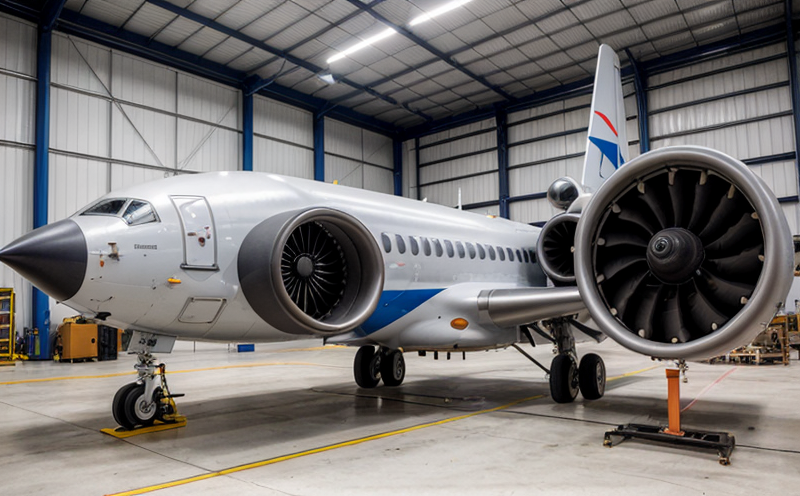Rotorcraft Vibration Fatigue Testing
The Rotorcraft Vibration Fatigue Testing service is designed to evaluate how components and systems within rotorcraft respond to cyclic mechanical stresses over time. This testing is critical for ensuring the safety, reliability, and longevity of aerospace structures, especially in environments where vibration-induced fatigue can lead to catastrophic failures.
Rotorcraft are exposed to complex vibratory conditions that vary with flight phases, including takeoff, cruise, and landing. These vibrations are a result of various factors such as engine operation, airframe flexibility, and external turbulence. Over time, these cyclic stresses can cause micro-cracks or permanent deformations in materials, leading to fatigue failure.
The primary objective of vibration fatigue testing is to simulate the real-world operating environment of rotorcraft components. This includes subjecting specimens to controlled cycles of stress that mimic the dynamic loading experienced during flight. The test setup typically involves a shaker system capable of producing controlled and repeatable vibratory loads. The frequency, amplitude, and duration of these cycles are precisely programmed to replicate the expected field conditions.
For this service, we employ state-of-the-art equipment such as sine and random vibration shakers that can generate complex waveforms with high precision. The testing process involves several key steps:
- Specimen Preparation: Components are carefully selected based on their critical role in the rotorcraft system.
- Loading and Fixturing: Specimens are securely mounted to ensure that they experience the intended cyclic loading conditions.
- Data Collection: Advanced sensors measure displacement, acceleration, and strain during each cycle. This data is used to monitor the onset of fatigue and assess structural integrity.
- Analysis and Reporting: Post-test analysis is conducted to determine the number of cycles before failure (NCF) and any other relevant parameters. A comprehensive report is provided detailing the test results, including graphs and charts for easy interpretation.
The Rotorcraft Vibration Fatigue Testing service adheres to international standards such as ISO 2631-1:2014 and ASTM E846, which provide guidelines for the testing of vibration-induced fatigue in aerospace components. Compliance with these standards ensures that the test results are valid and can be relied upon by regulatory bodies and end-users.
The importance of this service cannot be overstated, especially given the high stakes involved in rotorcraft operations. By identifying potential weaknesses early on, we help our clients prevent costly repairs and unscheduled maintenance, ensuring continued safe operation of their fleets.
Applied Standards
The Rotorcraft Vibration Fatigue Testing service is guided by a number of international standards that ensure the accuracy and reliability of our testing methodologies. These include:
- ISO 2631-1:2014 - Vibration—Evaluation of human exposure to whole body vibration
- ASTM E846 - Standard Practice for Vibration Testing of Aerospace Components
- ISO 7912:2003 - Acoustics—Measurement of sound pressure in the vicinity of rotating machines
- ASTM E846-18 Section 8.5 - Vibration Testing for Aerospace Components
These standards provide a framework for the precise measurement of vibration and its effects on components, ensuring that our testing aligns with industry best practices.
Eurolab Advantages
At Eurolab, we pride ourselves on delivering top-tier services tailored to meet the stringent requirements of aerospace and defense industries. Our expertise in rotorcraft vibration fatigue testing is complemented by our commitment to excellence:
- State-of-the-Art Facilities: Equipped with cutting-edge shaker systems capable of simulating real-world flight conditions.
- Certified Technicians: Our team consists of highly trained professionals who are experts in vibration testing methodologies and compliance with international standards.
- Comprehensive Reporting: Detailed reports provide insights into the test results, helping you make informed decisions about your product's performance and durability.
- Custom Solutions: We offer tailored solutions to meet the unique needs of each client, whether it's for a specific component or an entire system.
- Regulatory Compliance: Our services are designed to ensure compliance with all relevant aviation regulations and standards.
- Continuous Improvement: We regularly update our testing protocols and equipment to stay ahead of industry trends and technological advancements.
By choosing Eurolab for your rotorcraft vibration fatigue testing needs, you can be confident in the quality and reliability of our services. Our dedication to precision and innovation sets us apart as a leader in the aerospace sector.
Environmental and Sustainability Contributions
EuroLab's vibration fatigue testing contributes significantly to environmental sustainability through several key practices:
- Resource Efficiency: By providing accurate first-time-right results, we minimize the need for retesting, which in turn reduces energy consumption and waste generation.
- Material Conservation: Through precise testing protocols, materials are used more efficiently, reducing overall resource consumption.
- Energy Savings: The advanced equipment utilized at EuroLab is designed to operate with minimal energy loss, contributing to a reduction in carbon footprint.
- Reduced Waste: By ensuring the durability and reliability of components through rigorous testing, we help prevent premature failures that would otherwise lead to increased waste.
At EuroLab, sustainability is not just a goal but an integral part of our operations. We strive to make a positive impact on the environment while delivering world-class services to our clients.





